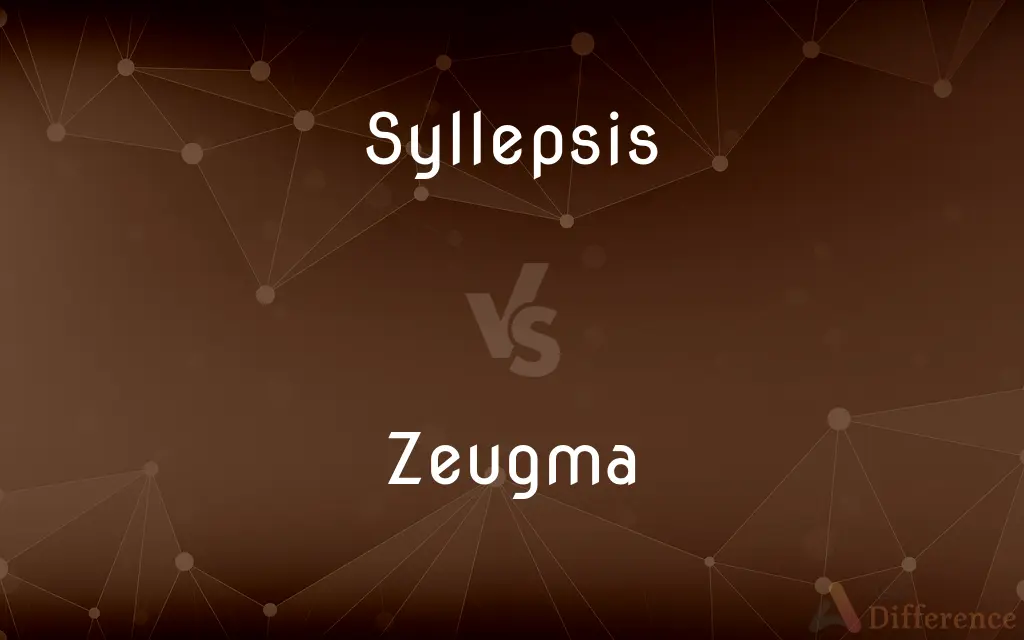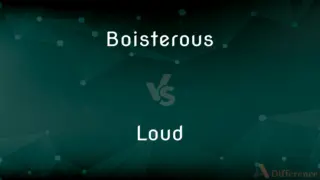Syllepsis vs. Zeugma — What's the Difference?
Edited by Tayyaba Rehman — By Urooj Arif — Updated on April 8, 2024
Syllepsis is a figure of speech where a word is applied to others in different senses, while zeugma strictly involves using a word to modify two or more words in the same way.

Difference Between Syllepsis and Zeugma
Table of Contents
ADVERTISEMENT
Key Differences
Syllepsis features a single word that is used in relation to two or more other parts of the sentence, but in a way that it only logically or grammatically applies to one of them. On the other hand, zeugma is a specific type of syllepsis where a single word, usually a verb or an adjective, governs two or more other words in a sentence, applying to them all in the same sense, either literally or metaphorically.
In syllepsis, the beauty lies in the clever play on words, allowing for a range of interpretations that can add depth or humor to a sentence. Zeugma, however, tends to be more structured, aiming for a stylistic effect by linking words together under the umbrella of a single controlling word, without the ambiguity or playfulness that characterizes syllepsis.
While syllepsis often hinges on a mix of metaphorical and literal meanings to create an interesting linguistic effect, zeugma usually sticks to a straightforward application of a single word to multiple others, making it a subset of syllepsis but with a narrower scope. This makes syllepsis a broader and more flexible rhetorical device.
The use of syllepsis can demonstrate the writer's linguistic skill and creativity, as it requires a nuanced understanding of words' multiple meanings. Zeugma, in contrast, showcases the writer's ability to create symmetry and parallelism in their writing, offering a sense of cohesion and balance to their sentences.
Syllepsis allows for a playful interaction between the different meanings of words, often leading to humorous or witty outcomes. Zeugma, while also capable of producing humor, tends to do so through the surprising conjunction of concepts under a single verb or adjective, rather than through the multifaceted application of a word.
ADVERTISEMENT
Comparison Chart
Definition
A figure of speech where a word is applied to others in different senses.
A specific type of syllepsis where a word governs two or more words in the same way.
Application
Can be both literal and metaphorical, or grammatically correct with only one.
Strictly involves a word modifying two or more words similarly.
Purpose
To create depth, humor, or ambiguity through varied meanings.
To achieve stylistic effect through symmetry and parallelism.
Scope
Broader, allowing more flexibility in usage.
Narrower, with a specific structural pattern.
Effect on Sentence
Introduces playful complexity and potential for multiple interpretations.
Adds cohesion and balance, sometimes humor, through surprising conjunctions.
Compare with Definitions
Syllepsis
A literary device where a word applies to two others in different senses.
She caught the train and a cold.
Zeugma
Creates an effect of symmetry and parallelism.
He wore a suit and a serious expression.
Syllepsis
Features a word that relates grammatically to only one part of the sentence.
She opened her door and her heart to the homeless puppy.
Zeugma
Aims for stylistic cohesion in sentences.
She broke his car and his confidence.
Syllepsis
Highlights the writer's wit and command of language.
He bolted the door and his dinner.
Zeugma
A figure of speech involving a word that applies to multiple words similarly.
She stole his heart and his wallet.
Syllepsis
Used to create humor or intrigue by linking unrelated terms.
He lost his coat and his temper.
Zeugma
Typically uses a verb or adjective to link different words.
The storm sank my boat and my dreams.
Syllepsis
Often relies on a mixture of literal and metaphorical uses.
They are fishing for compliments and trout.
Zeugma
Can produce humor through surprising connections.
He caught a fish and a cold.
Syllepsis
A verbal construction in which a word governs two or more other words but agrees in number, gender, or case with only one, or has a different meaning when applied to each of the words, as in He lost his coat and his temper.
Zeugma
Syllepsis.
Syllepsis
(rhetoric) A figure of speech in which one word simultaneously modifies two or more other words such that the modification must be understood differently with respect to each modified word; often causing humorous incongruity.
Zeugma
A construction in which one word or phrase is understood to fill a parallel syntactic role in two or more clauses or phrases, as with the verb was in She was upstairs, and her husband downstairs.
Syllepsis
(botany) Growth in which lateral branches develop from a lateral meristem, without the formation of a bud or period of dormancy, when the lateral meristem is split from a terminal meristem.
Zeugma
(rhetoric) The act of using a word, particularly an adjective or verb, to apply to more than one noun when its sense is appropriate to only one.
Syllepsis
A figure of speech by which a word is used in a literal and metaphorical sense at the same time.
Zeugma
(rhetoric) Syllepsis.
Syllepsis
The agreement of a verb or adjective with one, rather than another, of two nouns, with either of which it might agree in gender, number, etc.; as, rex et regina beati.
Zeugma
A figure by which an adjective or verb, which agrees with a nearer word, is, by way of supplement, referred also to another more remote; as, "hic illius arma, hic currus fuit;" where fuit, which agrees directly with currus, is referred also to arma.
Syllepsis
Use of a word to govern two or more words though agreeing in number or case etc. with only one
Zeugma
Use of a word to govern two or more words though appropriate to only one;
`Mr. Pickwick took his hat and his leave' is an example of zeugma
Common Curiosities
What is the purpose of using syllepsis?
Syllepsis is used for stylistic effect, often to create humor, intrigue, or to play with words' meanings.
What effect does zeugma have on writing?
Zeugma can enhance writing by creating a cohesive and balanced structure, often adding a layer of humor or surprise.
How does zeugma differ from syllepsis?
Zeugma is a type of syllepsis where a word governs two or more other words in the same way, without the differing senses characteristic of syllepsis.
How does zeugma affect sentence structure?
Zeugma adds symmetry and balance to sentences by applying a single word to multiple others in the same way.
Can zeugma be humorous?
Yes, zeugma can be humorous, especially when the linked words create an unexpected connection.
How does zeugma contribute to the coherence of text?
By linking different elements under a common verb or adjective, zeugma strengthens the coherence and unity of text.
Can syllepsis involve more than two words?
Yes, syllepsis can involve multiple words, as long as the governing word applies to them in different senses.
Is syllepsis a common figure of speech?
Syllepsis is less common in everyday speech but is celebrated in literature and poetry for its wit and creativity.
What makes zeugma appealing to readers?
The unexpected connections and the stylistic elegance of zeugma often make it appealing to readers.
What is syllepsis?
Syllepsis is a rhetorical device where a word is applied to two or more parts of a sentence in different senses.
How can writers effectively use syllepsis?
Writers can use syllepsis to showcase their linguistic creativity and to add layers of meaning to their sentences.
Can syllepsis create ambiguity?
Yes, syllepsis can introduce ambiguity or a double meaning, adding depth to the sentence.
Is syllepsis considered a sophisticated literary device?
Yes, syllepsis is considered sophisticated due to its reliance on the nuanced meanings of words.
Can syllepsis and zeugma coexist in a single sentence?
Yes, a sentence can feature both syllepsis and zeugma if a word applies to others in different senses and also governs them in the same way.
Does zeugma always involve humor?
While zeugma can be humorous, its primary function is to create a stylistic effect through structure and symmetry.
Share Your Discovery

Previous Comparison
Sometime vs. Someday
Next Comparison
Boisterous vs. LoudAuthor Spotlight
Written by
Urooj ArifUrooj is a skilled content writer at Ask Difference, known for her exceptional ability to simplify complex topics into engaging and informative content. With a passion for research and a flair for clear, concise writing, she consistently delivers articles that resonate with our diverse audience.
Edited by
Tayyaba RehmanTayyaba Rehman is a distinguished writer, currently serving as a primary contributor to askdifference.com. As a researcher in semantics and etymology, Tayyaba's passion for the complexity of languages and their distinctions has found a perfect home on the platform. Tayyaba delves into the intricacies of language, distinguishing between commonly confused words and phrases, thereby providing clarity for readers worldwide.














































